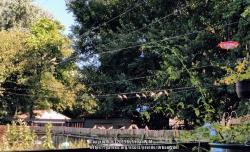We have a small lot. About 1/4 acre which includes the footprints of two buildings. We've been building habitat connections for wildlife with a heavy lean towards pollinators. We're urban (big surprise) and when we first bought the property, we started laying the plant foundations with a special eye towards early and late season flowering plants. Little by little we've added numerous different birdhouses, several water sources, left some bare ground for native bees, etc.
One of the results of 20+ years of the pepper owners neglect and lack of oversight with contractors is that there were over 50 wires running from the alley to the main house. I called the various utilities to have them remedy the mess that accumulated. Between what they did, then some additional removals I made, we're down to six wires. I had planned on the long term goal of 0-1 wires. We've softened a bit on the wires due to bird usage. The wires are used constantly by birds as temporary roosts, the last stop before hitting the feeders and those awaiting a place at the feeders. This photo could be any given minute out there but in winter, there might be 80 doves on wires with over a hundred in the yard.

Anyway, we're now counting that as one of the ways the yard has been modified to accommodate wildlife. It left me thinking about other little things which could also support wildlife. For example, we've been looking at adding more cover for the lizards. At the same time we noticed container plants sitting on the ground would eventually have drainage holes blocked turning them into mini swamps. In order to address both, we propped containers up on bricks with fair sized gaps between them. Two birds, one stone. The result was immediate use by lizards, and pots again had decent drainage.
So, I'm wondering if folks here have some novel habitat mods they've made which can fit in a smaller urban garden?
We bought 8 small bird houses from Lowe's a couple of years ago. They were supposed to be Wren boxes but the hole was too small and the build inappropriate. However, I immediately saw their utility for nesting bumble bees. We mainly get Bombus impatiens and they commonly inhabit birdhouses. Success came a year later. Good for them and good for my tomatoes!

I have a number of artificial tube nesting habitats of several different materials that I created for solitary bees as well.
Anyone else?
